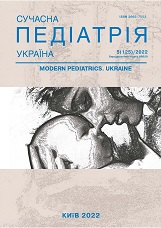The course of COVID-19 in hospitalizef children
DOI:
https://doi.org/10.15574/SP.2022.125.12Keywords:
COVID-19, children, comorbidity, hospitalizationAbstract
Purpose - to study the features of COVID-19 in hospitalized children.
Materials and methods. Retrospective multicenter clinical and epidemiological study which includes 328 hospitalized children with laboratory-confirmed COVID-19 for the period from January to August 2021.
Results. the highest specific weight among all hospitalized children falls on children of the first year (75/328; 22.8%), in general, early childhood (up to 3 years) accounted for 43% (141/328) of all hospitalizations of children with COVID-19. Common symptoms of the disease included fever, upper respiratory symptoms, intoxication, diarrhea. In 99/328 (30.1%) hospitalized children pneumonia has developed, 50/99 (50.5%) of which needed oxygen support, 10/99 (10.1%) - mechanical ventilation. Pneumonia was most common in children under 1 year, children of the first 5 years of life accounted for more than a half of all pneumonia cases (53/99; 53,5%). 13/328 (3.9%) children were hospitalized to the intensive care unit. Comorbidities including endocrine, oncological, neurological diseases, congenital malformations and others, were noted in 24.6% of hospitalized children. In children with comorbid conditions, pneumonia occurred 2 times more often (relative risk factor RR=1.98, CI 95%), the relative risk of getting into resuscitation RR in the presence of comorbidity is 10.86 (CI 95%). In addition to children with pneumonia, oxygen support or mechanical ventilation required children with obstructive syndrome, pancytopenia, convulsions. The largest proportion of comorbidities in patients hospitalized to the intensive care unit were diseases of the nervous system (congenital malformations of the CNS, cerebral palsy, epilepsy, astrocytoma). Lymphopenia and thrombocytopenia were most commonly associated with severe COVID-19.
Conclusions. Children of all ages are susceptible to COVID-19. The main risk factors for severe disease are early age and the presence of comorbid conditions, among which the most relevant are diabetes, obesity, neurological diseases and cancer. The presence of comorbidities in children determines the priority groups for the prevention of coronavirus infection through vaccination.
The research was carried out in accordance with the principles of the Helsinki Declaration. The study protocol was approved by the Local Ethics Committee of the Shupyk National Healthcare University of Ukraine. The informed consent of the patient was obtained for conducting the studies.
No conflict of interests was declared by the authors.
References
Assaker R, Colas AE, Julien-Marsollier F et al. (2020). Presenting symptoms of COVID-19 in children: a meta-analysis of published studies. Br J Anaesth. 125: e330-2. https://doi.org/10.1016/j.bja.2020.05.026; PMid:32534738 PMCid:PMC7261471
Casanova J-L, Su H, COVID Human Genetic Effort. (2020). A Global Effort to Define the Human Genetics of Protective Immunity to SARS-CoV-2 Infection. Cell. 181 (6): 1194-1199. https://doi.org/10.1016/j.cell.2020.05.016; PMid:32405102 PMCid:PMC7218368
CDC. (2020). Coronavirus disease 2019 (COVID-19): People with certain medical conditions. U.S. Centers for Disease Control and Prevention. URL: https://www.cdc.gov/coronavirus/2019-ncov/need-extra-precautions/people-with-medical-conditions.html.
CDC. (2020). Centers for Disease Control and Prevention. Information for Pediatric Heath Care Providers. URL: www.cdc.gov/coronavirus/2019/ncov/hcp/pediatric-hcp.html.
Dhochak N, Singhal T, Kabra SK, Lodha R. (2020). Pathophysiology of COVID-19: Why Children Fare Better than Adults? The Indian Journal of Pediatrics. 87: 537-546. https://doi.org/10.1007/s12098-020-03322-y; PMid:32410003 PMCid:PMC7221011
Dong Y, Mo X, Hu Y et al. (2020). Epidemiological characteristics of 2143 pediatric patients with 2019 coronavirus disease in China. Pediatrics. https://doi.org/10.1542/peds.2020-0702; PMid:32179660
Fang F, Lu X. (2020). Facing the pandemic of 2019 novel coronavirus infections: the pediatric perspectives. Chinese Journal of Pediatrics. 2 (58): E001. doi: 10.3760/cma.j.issn.0578-1310.2020.0001.
Goyal MK et al. (2020). Racial/ethnic and socioeconomic disparities of SARS-CoV-2 infection among children. Pediatrics. 146 (4): e2020009951. https://doi.org/10.1542/peds.2020-009951; PMid:32759379
Hoang A, Chorath K, Moreira A et al. (2020). COVID-19 in 7780 pediatric patients: A systematic review. E. Clinical Medicine. 24: 100433. https://doi.org/10.1016/j.eclinm.2020.100433; PMid:32766542 PMCid:PMC7318942
Hong H et al. (2020). Clinical characteristics of novel coronavirus disease 2019 (COVID-19) in newborns, infants and children. Pediatrics & Neonatology. 61 (2): 131-132. https://doi.org/10.1016/j.pedneo.2020.03.001; PMid:32199864 PMCid:PMC7129773
Kim L et al. (2020). Hospitalization rates and characteristics of children aged <18 years hospitalized with laboratory-confirmed COVID-19 - COVID-NET, 14 states, March 1-July 25, 2020. Morbidity and Mortality Weekly Report. 69 (15): 458-464. https://doi.org/10.15585/mmwr.mm6915e3; PMid:32298251 PMCid:PMC7755063
Lee P et al. (2020). Are children less susceptible to COVID-19? Journal of Microbiology, Immunology and Infection. 53 (3): 371-372. https://doi.org/10.1016/j.jmii.2020.02.011; PMid:32147409 PMCid:PMC7102573
Lu X et al. (2020). SARS-CoV-2 infection in children. New England Journal of Medicine. 382: 1663-1665. https://doi.org/10.1056/NEJMc2005073; PMid:32187458 PMCid:PMC7121177
Posfay-Barbe KM et al. (2020). COVID-19 in children and the dynamics of infection in families. Pediatrics. 46 (2): e20201576. https://doi.org/10.1542/peds.2020-1576; PMid:32457213
Rubens JH, Akindele NP, Tschudy MM. (2021). Acute covid-19 and multisystem inflammatory syndrome in children. BMJ. 372: n385. https://doi.org/10.1136/bmj.n385; PMid:33648933
Tregoning JS, Schwarze J. (2010). Respiratory viral infections in infants: causes, clinical symptoms, virology, and immunology. Clin Microbiol Rev. 23: 74-98. https://doi.org/10.1128/CMR.00032-09; PMid:20065326 PMCid:PMC2806659
Viner RM et al. (2020). Susceptibility to SARS-CoV-2 infection among children and adolescents compared to adults: A systematic review and meta-analysis. JAMA Pediatrics. 175 (2): 143-156. https://doi.org/10.1001/jamapediatrics.2020.4573; PMid:32975552 PMCid:PMC7519436
Zhang L, Peres TG, Silva MVF, Camargos P. (2020). What we know so far about Coronavirus Disease 2019 in children: A meta-analysis of 551 laboratory-confirmed cases. Pediatr. Pulmonol. 55: 2115-2127. https://doi.org/10.1002/ppul.24869; PMid:32519809 PMCid:PMC7300763
Zimmermann P, Curtis N. (2020). Arch Dis Child: 1-11. https://doi.org/10.1136/archdischild-2020-320338; PMid:33262177
Downloads
Published
Issue
Section
License
Copyright (c) 2022 Modern pediatrics. Ukraine

This work is licensed under a Creative Commons Attribution-NonCommercial 4.0 International License.
The policy of the Journal “MODERN PEDIATRICS. UKRAINE” is compatible with the vast majority of funders' of open access and self-archiving policies. The journal provides immediate open access route being convinced that everyone – not only scientists - can benefit from research results, and publishes articles exclusively under open access distribution, with a Creative Commons Attribution-Noncommercial 4.0 international license (СС BY-NC).
Authors transfer the copyright to the Journal “MODERN PEDIATRICS. UKRAINE” when the manuscript is accepted for publication. Authors declare that this manuscript has not been published nor is under simultaneous consideration for publication elsewhere. After publication, the articles become freely available on-line to the public.
Readers have the right to use, distribute, and reproduce articles in any medium, provided the articles and the journal are properly cited.
The use of published materials for commercial purposes is strongly prohibited.

